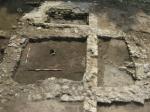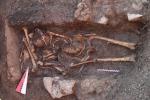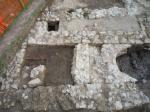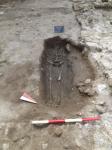Summary (English)
Trenches CXI and CXII revealed a series of structures belonging to at least two buildings. The earlier one (early 1st century A.D.) was only partially intercepted, and the later building (early 2nd century A.D.?) was restructured several times during its occupation that continued until the 6th century A.D.
Trench CXI occupies the southern sector of the area; during the 2014 season, the investigations were concentrated in its south-eastern.
The removal of the surface levels exposed a series of structures belonging to three rooms; work centred on rooms 2 and 3 (Fig. 1).Room 2 (2.85 × 2.75 m), had wide perimeter walls (0.6 – 0.7 m) built with very roughly hewn stone bonded with mortar. The floor was formed by a sandy layer, a loose make up of pottery and brick/tile fragments, a layer of cobbles and a surface of horizontally placed broken tiles. The pottery recovered dated to the central decades of the 2nd century A.D.
The walls uncovered to the south of room 2 date to the same period. In this sector, an earlier structure of broken brick/tile bonded with clay was replaced some time later (period unknown) by the construction of a new room (n.3; 2.6 × 3.2 m).In the late antique period (late 5th-mid 6th century A.D.) a necropolis with earth graves was created. One of the burials, partially bordered by tiles and reused stones, cut the west wall of room 3. A female individual had been buried in a pre-existing grave and the bones of the first individual – except the cranium – were repositioned in its westernmost part (Fig. 2).
In trench CXII, a series of walls were exposed below the destruction levels that indicated the presence of two buildings. One had walls built in ashlar blocks of panchina livornese (a type of sandstone) bedded and bonded with mortar. Similarities in construction technique with the horreum present in the northern sector of the site dating to the beginning of the 1st century A.D. make it possible to suggest, with due caution, that this structure dates to the same period.
In the second phase (early 2nd century A.D.), this room was incorporated into the main structure, whose walls had a different construction technique: medium to large stones from the river (cobblestones?) bonded with abundant mortar. A covered cistern was created in one of the rooms, probably exploiting spring water.
The building had a long life, probably until the late antique period when it was used for funerary purposes: two enchytrismós burials (a child and a badly disturbed burial) and an earth grave containing an adult individual without grave goods (Fig. 4). The grave burials were aligned east-west with the raised cranium to the east, while the two enchytrismói were on a north-south alignment suggesting differences in funerary ritual and period.The finds date this final phase of the building’s use to the 7th century A.D.
- Paolo Sangriso – Università degli Studi di Pisa, Dipartimento di Civiltà e Forme del Sapere.
- Stefano Genovesi – Università degli Studi di Pisa, Dipartimento di Civiltà e Forme del Sapere
Director
- Marinella Pasquinucci - Università degli Studi di Pisa, Dipartimento di Civiltà e Forme del Sapere.
- Simonetta Menchelli - Università degli Studi di Pisa Dipartimento di Civiltà e Forme del Sapere.
Team
Research Body
- Università degli Studi di Pisa, Dipartimento di Civiltà e Forme del Sapere.
Funding Body
- Comune di Rosignano Marittimo
- Fondazione Cassa di Risparmi Livorno
- Ineos Manufacturing Italia S.p.A.
- Società Chimica Solvay
- Università degli Studi di Pisa






![Download [PDF]](/excavation/skins/fasti/images/results/download_sml.png)


